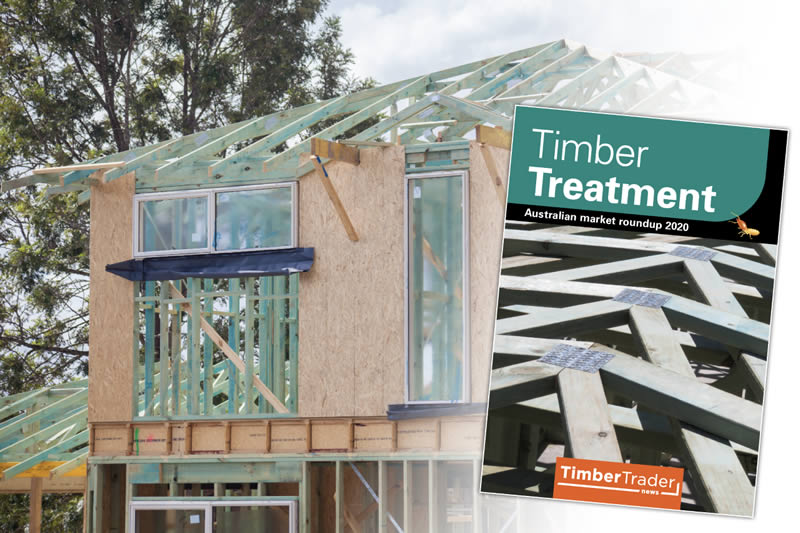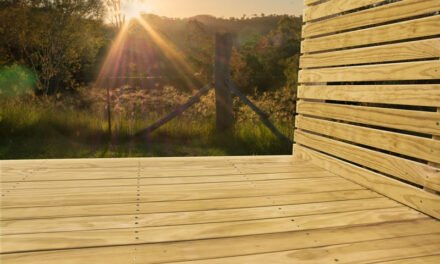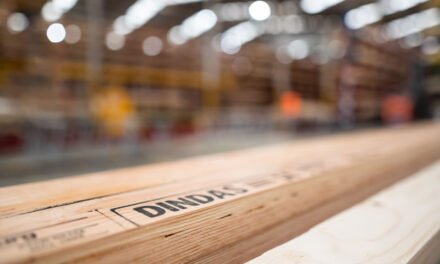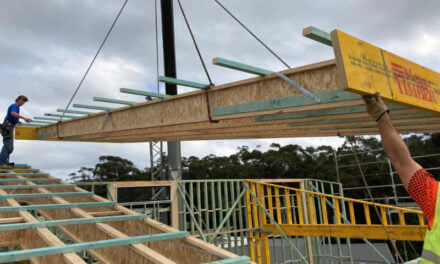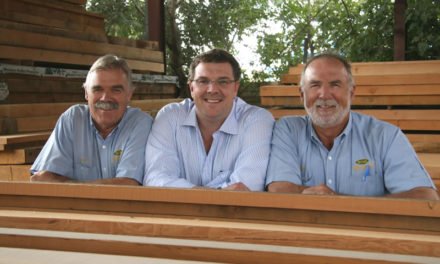They’re essential to our building industry, but not always fully understood. TTN’s 2020 timber treatment booklet covers what you need to know.
You’d be forgiven for imagining that treated timber is standard in every Australian build. With several of the world’s most destructive termites living in here and a climate that believes in both soaking rains and punishing dryness, treatment that will dramatically improve durability in structural and other timbers seems a no-brainer. But a surprising number of Australian builders aren’t using treated product, even in housing frames.
“In Melbourne, hardly anyone uses treated pine,” says John Halkett, general manager of the Australian Timber Importers Federation (ATIF). “But they should definitely be thinking about it. Thanks to climate change, termites are on the move and are already south of Sydney. Plus, you get all the benefits for preventing moisture damage, all for the sake of about $800 or so to treat the average house-load of framing timber.”
Halkett points out that the industry needs to shoulder some of the blame for this. On the one hand, developers offer treatment as an added value option: “The home buyer is at the display home and the salesperson is saying ‘OK, so with this last bit of the budget, do you want to put in an air conditioner, or treat the timber framing?’ and they go with the air conditioner because no one explains to them the long-term costs,” he says, adding that structural repairs due to insect and damp damage often start around the $10,000 mark and can skyrocket from there.
On the other hand, too much faith has been put in barrier treatments for borers and termites. “They’re a good product,” Halkett says, “but the reality is five years later, people have forgotten about them and they’ve put in a garden bed against the bottom of the weatherboards and they haven’t refilled the insecticide reservoirs, so it’s useless. Whereas if there’s treated framing, it just keeps going.”
Additionally, treated timber product comes with extra protections for the end user.
Jack Norton, national secretary of the Timber Preservers Association of Australia (TPAA), says, “The Building Code of Australia gives six years for its statutory warranties, and timber will most likely take longer than six years to fail. But if you’ve installed branded treated timber product, then there are also protections under the consumer act. If it fails, the manufacturer has produced something that isn’t compliant. Properly treated timber will not fail. So the homeowner has additional protections under Australian Consumer Law.”
Some of these are explicitly set out in branded treated product warranties, which go well beyond the BCA standard – up to 25 years in some cases.
Even if builders and fabricators aren’t personally convinced by the benefits of treatment, it doesn’t matter. “The steel guys are using this as promotion,” says Halkett. “They say that steel framing is termite proof, so we need to get builders and frame and truss people into prescribing H2 treatment as standard so that they’re not beating out timber on that claim.”
Trust the brand
‘Treated timber’ is a much bigger category than the familiar blue frames and trusses. There are some 15 different active ingredients currently approved for timber treatments, not to mention combinations. So how do you know what to buy for a given purpose?
“It’s a results-driven specification,” says Norton. “The Building Code of Australia says something along the lines of ‘the timber will be the right durability’. That can be either natural durability or treated. Timber is treated to a specific hazard class depending on the use: is it inside? Use H1 or H2. Outside above ground? H3. In ground contact? H4 or higher. Match the conditions to the hazard class and it’s straightforward.”
The national treatment Standard (AS 1604 series) says that every product that claims it complies with the standard needs to carry certain information. This is attached to each board, usually as a tag nailed to one end or else branded onto the face of the board, and lists three codes. The first identifies the treatment plant, the second the chemical/s used in the treatment and the third the hazard class that the product has been treated to.
“There’s a new version of the standard that’s due out,” says Norton, “and it’s changing the term from a ‘treatment plant number’ to a ‘unique identifier’. That means people will be able to put their company name on the treated product rather than the current number. The number means nothing to a buyer, unless they go to our website and chase it down.”
TPAA lists about 100 Australian plants and 100 imported plants on their website. “We don’t register those brands,” Norton points out. “We just list them. The new Standard says something along the lines of ‘organisations such as TPAA hold a list of brands’, so we’re part of the chain of custody in that we’re providing a service to the user to indicate who treated the timber and to what level and with what compound. That helps the producer and the user to see what the product is and feel confident it’s compliant with the Standard.”
But, he warns, there’s no regulatory power attached to that. “In the old days, Queensland and NSW had legislation that governed what was done with treated timber but those days are gone,” Norton says. “There’s no policing. So while many treatment plants have good quality systems and make use of the companies that do testing for the treatment plants – and there are contractors who do the same – there’s no legal requirement to ensure that the product meets specifications. There’s nobody who goes out to a building site or to a construction or even a pack of timber, takes a sample and tests for compliance.”
The brand then becomes key. “If they put a brand on it, they’re making a claim it complies with the treatment standard,” Norton says. “Any company that doesn’t will feel that in terms of damaged reputation and in terms of paying to fix problems where the product hasn’t been compliant with what you’ve told the consumer and the certifier.”
Meeting the standard
Halkett says the timber importers he works with fall into two groups: “The bigger companies, like Stora Enzo, get their product treated to Australian Standards before bringing it in. The smaller companies bring it in raw and either use a local treatment firm, or if it’s just a spray treatment, use their own in-house facility. Half a dozen ATIF members treat their own H2 and H3 in house, so that they can make sure it meets the requisite Australian Standards.”
That’s not as simple as it sounds: Halkett recounts the story of major Canadian exporter Canfor having to spend about $3 million to change their board marking system to meet the Australian Standard for MGP10 product.
“Similar issues apply for treated timber: it has to be marked in accordance with the Standard,” says Halkett. “My advice is always ‘Stick with the Standard, mate, and if you can’t meet it, don’t bother.’ But it’s the same story for both local and imported product: good suppliers will have – and will hand over – the information on what they’ve used.”
Halkett warns that a looming under-supply of local timber means that when the economy recovers from this contraction, we will be reliant on imports to meet the demand for structural pine in particular.
“We’ve got local stalwarts like Shane Vicary at AKD doing a great job of maximising the saw log recovery from the fires,” he says, “but when housing ticks up again, we will need more. That will have to come from the Northern Hemisphere, so it’s important to make sure new Russian, European or Canadian suppliers understand the BCA and Standards requirements. Compliance with machine stress grading and treatment requirements are going to be key issues.”
ATIF has been working with suppliers interested in the Australian market to educate them and ensure that imported product complies with legal logging, biosanitary and BCA and Australian Standards requirements.
“We’re talking with the Russians at the moment,” Halkett says, “because there’s been problems with Russian wood in the past. One company that now imports significant volumes of Russian timber has solved these by doing the machine stress grading in Sydney and also the H2 treatment. We’ve had it independently verified and now they can get MGP10 H2 compliant with the Standard.”
Consumer security
After Grenfell and Opal Towers, compliance and safety are big issues for both builders and home buyers. TPAA works closely with the industry to educate treaters, suppliers and retail customers alike about treatment processes and chemicals. Members are encouraged to take advantage of the quality assurance and product testing programs the association has helped to develop and a wide range of fact sheets and other technical publications are freely available.
“Will buying treated timber mean you can be sure there won’t be problems? No,” Norton says. “But there are safeguards. Customers need to look for that brand on their product. Unfortunately much of it is done in the form of a plastic tag stapled to the end of a piece of wood, and the first thing a carpenter will do is cut the end off to make it square. So we urge people to keep detailed records, to keep copies of the brands and to take photographs. That way they can ensure they are getting a branded product and if it fails, they can go to the treatment plant and say, ‘Hey, this is your product, here’s the chain of custody, you need to fix this.’”
Norton and Halkett both emphasise that no timber will work optimally in applications beyond those it’s designed for. “Even some perfectly treated timbers need their ends repainted after they’ve been cut,” Halkett says. “So check your product details.”
The same is true for treated engineered wood products (EWP). Kent Powell, national sales and marketing manager at Myer Timber says, “After 24 years in the EWP game the one constant I’ve observed is that EWP applied with any H3 Treatment alone don’t solve all of your customers’ weather-exposed challenges. It is critical to put some safety around your business and your customers by providing relevant installation and maintenance guides to avoid disappointment.”
Meyer, like all the major EWP suppliers, has this information already available for their customers. Powell emphasises that although engineered products like LVL, I-joists and glulam are sophisticated and cost a little more, “the fact is that they’re softwood products and no matter what, reaction to moisture uptake will be exactly like a piece of untreated pine with regard to movement, distortion, cupping and surface checking and in extreme cases splitting. So without correct installation and maintenance, the extra money spent will often not meet the client’s expectation, resulting in an unsatisfied customer.”
New products
Looking at the range of treatment products and processes, every one on the market has its place when it comes to satisfying customers’ various and often competing needs. Some will treat to a higher hazard class, but may cost more; some are cheaper, but may require more protection from exposure; some have restrictions on use in high-contact areas, but represent good value for industrial or agricultural users.
The leading treatment chemical suppliers, particularly Lonza Wood Protection and Koppers Performance Chemicals, invest consistently in research. Every few years something genuinely new comes to market that will have its own point of difference.
Most recently, that’s a new roundwood product called Tanapost. Halkett says, “It’s just been rolled out in SA by a company called Roundwood Solutions and is reputed to be an H4 treatment that doesn’t have the heavy metal problems which CCA treatment has had, relating to end-of-life disposal and the tendency to burn in bushfires. This product is more like natural wood in that it will char, but survive most fire fronts that pass through.”
It’s part of a general market trend to more environmentally friendly credentials and products that look at the whole-of-life process. “It’s a good move, as long as they can do the job,” says Halkett. “There’s been several new processes come out in recent years that tick these boxes, which is great, because people do want solutions that will store carbon and deliver the other benefits of wood.”
Suppliers are more than happy to advise customers with special requirements on suitable product, but, as Norton says, “Everything that has been done to specification is safe. If it’s got an H3 brand, you can use it in that application and it doesn’t matter what it’s treated with. You can rely on it to perform at H3, whatever black magic is done in the treatment plant. By the time it comes to market, it has APVMA approval, which means the producer has gone through a set of established assessment protocols – usually the ones at www.tpaa.com.au/TPAA/wp-content/uploads/2015/06/4_1_0_0-AWPC-Protocols-2015.pdf
“People don’t need to know the details. All they need to know is that it’s gone through an assessment process, it’s got into the standard, and if the product has a brand on it, they can use it with confidence.”
Click here for a link to download the booklet.

